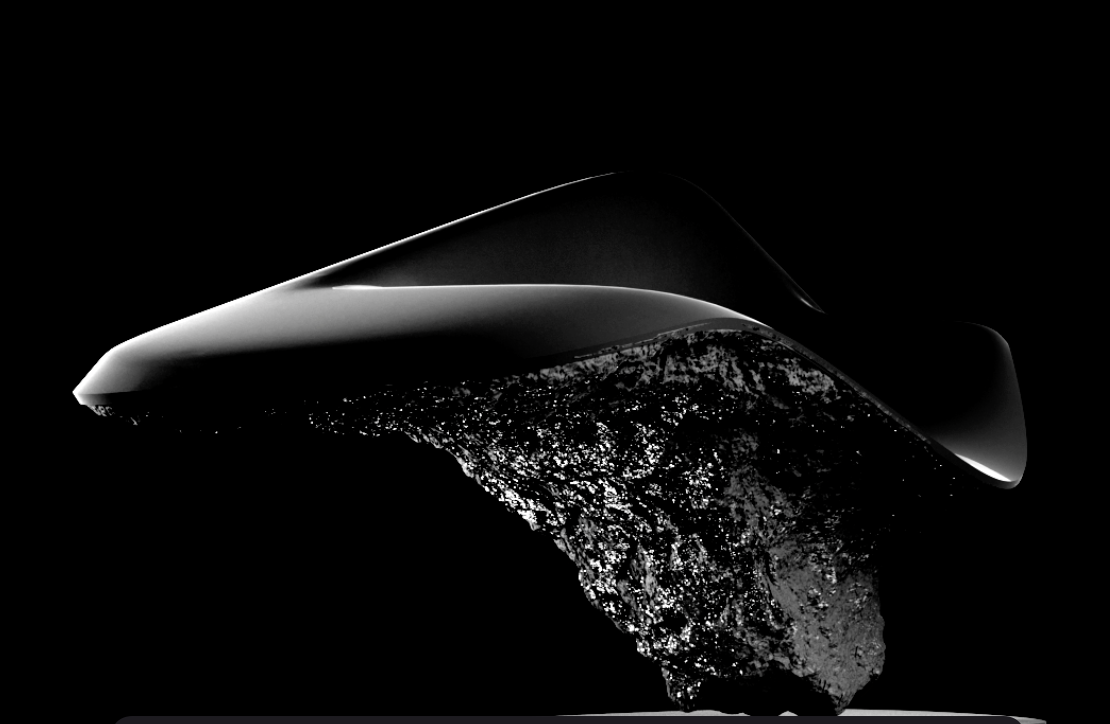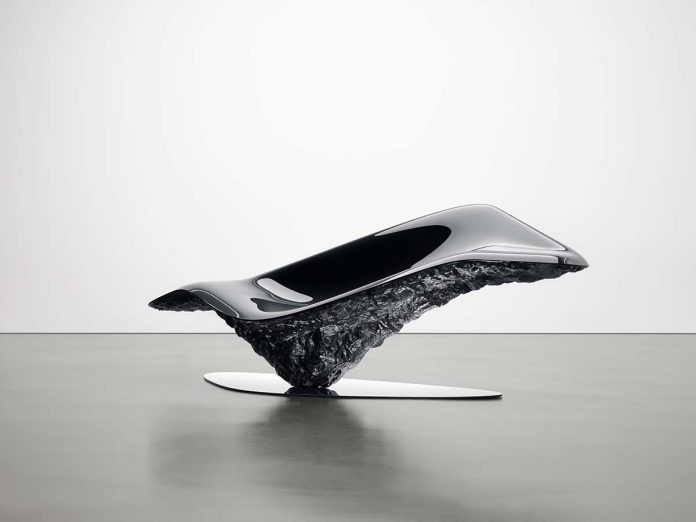With a sleek upper surface echoing the fluid, refined lines of Pininfarina’s most iconic automotive designs, and a rough, rugged, and robust lower part reminiscent of the solidity of rock formations, the Oksýs chaise lounge stands as a testament to Pininfarina Architecture’s inaugural foray into collectible design. These contrasting elements are brought together harmoniously, giving the Oksýs a unique allure deeply rooted in tradition. Crafted in Pininfarina’s in-house workshops in Cambiano, Turin, the Oksýs chaise lounge, emerging from a meticulous single aluminum casting process, epitomizes the notion that the artificial and the natural, human beings and nature, are not opposing elements, but rather complementary components of the same concept.
Presented during Milan Design Week at the prestigious Rossana Orlandi Gallery, the Oksýs chaise longue grew out of a dynamic collaboration between Pininfarina’s esteemed Architecture and Product Design divisions. The piece epitomizes Pininfarina’s illustrious heritage, which spans over 90 years of Italian design excellence and innovation, while also serving as a beacon for the company’s forward-looking vision for the future. Pininfarina’s legacy has been intricately intertwined with the concept of “collectability” since its inception. Founded by Battista Farina in 1930, the company’s primary objective was to craft high-end and luxury automobiles that could transcend mere transportation to become coveted collectible pieces, designed and built to fulfill the dreams of their future owners. From the outset, Pininfarina cars were akin to works of art, marked by exquisite craftsmanship and distinctive attributes reminiscent of haute couture garments. Crafted under the creative direction of Marco Becucci from the Pininfarina Architecture team, and produced in a limited run of just three pieces, the Oksýs was selected by an esteemed commission comprised of gallery owner Rossana Orlandi, designer and entrepreneur Giulio Cappellini, and Pininfarina Chairman Paolo Pininfarina. Giovanni de Niederhäusern, head of the brand’s Architecture and Product Design team, provides insights into this groundbreaking venture—the first collectible design project under the banner of Pininfarina Architecture.

How did you decide to venture into collectible design? While it’s true that Battista Farina’s cars also originated from the concept of collectibles, the contemporary landscape has since evolved. What does it mean in today’s context to create an object intended for a select few?
“The aim of creating uniquely exquisite pieces, marked by meticulous attention to detail, has long been woven into the very fabric of Pininfarina’s essence. The Oksýs seeks to revive this ethos in its purest form while reflecting on the brand’s evolution by venturing into furniture design. Crafting a singular or limited-edition object today, particularly within a long-standing company such as ours, offers us the opportunity to push the boundaries of creativity to the fullest extent, unrestricted by anything other than the limits of creativity itself.”
Can you explain your vision of the complementarity of the artificial and the natural, humans and nature? In the Oksýs, this notion appears to translate into contrasts between lines, shapes, and perceptions. The concept is intriguing, but how can it be implemented in a society dominated by “artificial” elements such as AI, the digital world, and social media? Are boundaries necessary for maintaining a balance between these opposing forces? What are the potential risks of highlighting the contrast between these artificial and natural elements?
“The Oksýs embodies an oxymoron: the natural and the artificial, two contrasting elements, yet coexisting within the same reality. While tools such as AI and digital platforms can help us to create new objects or elements, they are still inherently derived from nature. Rather than focusing on boundaries, as exemplified by the Oksýs, I would advocate for pursuing balance.”

When did the project that led to the creation of the Oksýs begin? What prompted establishing an order akin to a “competition”? How and why did this concept come about? Can we anticipate any continuation of this project?
“The idea to create a collectible item under the Pininfarina brand emerged about a year ago, driven by our aim to revive the intersection between design and art evident in many of our past endeavors. Creativity at Pininfarina is collaborative: several members of the Architecture and Product team were tasked with developing collectible concepts that aligned with the company’s legacy and crafting expertise. After careful consideration, the Oksýs was chosen by Rossana, Giulio, and the President as the most original project, with the piece being deemed an effective example of exemplary design and craftsmanship.”
How does Pininfarina, as a brand, intend to pursue this path in collectible design? Will the Oksýs remain a standalone project?
“At Pininfarina, we’ve always designed unique objects for our clients, especially in the residential sector. The Oksýs represents the transposition of this expertise into the world of art galleries, blending art and design together. We certainly plan to release more pieces in the future, but this will be done organically and at our own pace.”
Let’s talk about the world of design/interior design and the world of automotive design. Where are they heading? Are they on the right path? How can we improve their trajectory?
“Both the worlds of design/interior design and automotive design are undergoing significant changes, driven by technological advancements, evolving consumer demands, and a growing emphasis on sustainability. Continuous commitment to technological innovation, environmental sustainability, and enhancing user experience are indisputably essential to ensure progress in both of these areas.”
Pininfarina Architecture has achieved and continues to achieve global recognition. Why do you think this is? What are the guiding principles behind the work of your collaborators?
“In the past, I often worked in environments where creativity was centered around a single key figure. But, at Pininfarina Architecture, creativity is distributed collaboratively and equally across the team. Our approach is guided by a rich historical heritage, a well-defined methodology, and, most importantly, a clear vision for the future.”







